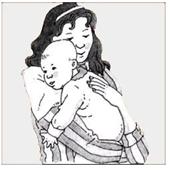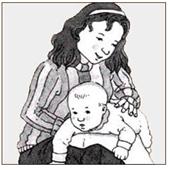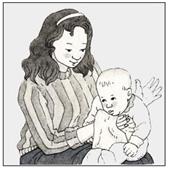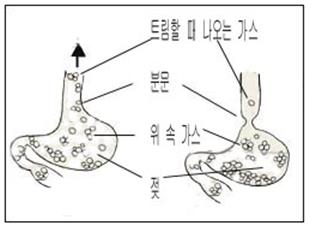트림시키기, Burping

그림 4-19. 아기를 엄마의 앞가슴에 안고 트림시킬 수 있다.
Copyright ⓒ 2011 John Sangwon Lee, MD., FAAP

그림 4-20. 아기를 엄마의 무릎 위에 엎어 안고 트림시킬 수 있다.
Copyright ⓒ 2011 John Sangwon Lee, MD., FAAP

그림 4-21. 아기를 엄마의 무릎 위에 세워 앉히고 트림시킬 수 있다.
Copyright ⓒ 2011 John Sangwon Lee, MD., FAAP
- 아기들이 왜 트림을 하는지 왜 트림을 시켜야 하는지 트림하는 정상 생리에 대해서 여기서 알아본다.
- 식도관 하단 속에서 위(胃) 속으로 이행되는 식도의 최 하단 부분을 분문이라고 한다.
- 이 분문에는 분문이 열렸다 닫혔다 하게 하는 괄약근육이 있다. 이 근육을 분문 괄약근이라고 한다.
- 누구든지 정상적으로 분문에 괄약근이 있다.
- 먹은 모유나 인공영양이 전체 식도관 속을 지나 식도관 속 최 하단에 있는 분문에 이르면 분문이 열리고 그 열린 분문을 통해 먹은 모유, 인공영양 또는 음식물이 위 속으로 들어가는 것이 정상 생리이다.
- 음식물이 식도관 속 최 하단에 있는 분문을 통과해서 위 속으로 들어가자마자 분문이 닫히는 것이 정상이다. 이런 현상은 신생아들, 영아들, 학령기 아이들 또는 성인들 모두에 정상적으로 생긴다.
- 대략 1세 이후 유아기 아이들이나 그 이후 학령기 사춘기 아이들이나 성인들이 음식물을 먹은 후 바로 물구나무서기를 해도 방금 전에 먹었던 위 속 음식물이 위 속에서 분문을 통과해서 식도관 속으로 역류돼서 입 속으로 넘어 나오지 않는 것이 보통이다.
- 그러나 신생아들이나 1세 이전 영아들의 분문의 괄약근은 1세 이후 더 큰 아이들이나 성인들의 괄약근에 비해 생리적으로 더 미약하다.
- 신생아들이나 영아들이 모유나 인공영양, 그 외 다른 음식물을 먹은 후 분문이 생리적으로 쉽게 열릴 수 있다. 그래서 먹은 위 속 모유나 인공영양이나 공기가 열린 분문을 통과 해 식도관 속으로 쉽게 역류될 수 있다. 그 역류된 식도관 속 내용물이 전 식도관 속을 거쳐 입 속으로 역류되어 넘어올 수 있다.
- 신생아들이나 영아들은 젖이나 인공영양을 먹을 때 젖이나 인공영양과 공기를 함께 많이 빨아 삼키는 것이 보통이다.
- 모유나 인공영양을 빨아먹을 때 공기를 더 많이 빨아먹을수록 위 속에 더 많은 공기가 있을 수 있다. 이런 경우 트림을 더 많이 할 수 있다. 때로는 먹은 모유나 인공영양을 공기와 함께 괼 수 있다.
- 수유 중 공기를 더 많이 빨아먹으면 트림을 더 많이 할 수 있고 더 쉽게 더 괼 수 있다. 이런 이유 때문에 모유나 인공영양을 많이 먹은 후 건강한 신생아들이나 영아들을 좀 더 심하게 다루거나 모유나 인공영양을 먹이는 동안 트림을 적절히 시키지 않으면 먹은 젖이 위 속에서 분문을 통과한 후 식도관 속을 통과해서 입으로 쉽게 넘어올 수 있다.
- 신생아들이나 영아들은 젖이나 인공영양을 먹을 때 공기를 더 많이 삼키는 것이 보통이다.
- 모든 것이 미약해서 그렇게 공기를 모유와 함께 삼키고 그것을 도로 넘기는 현상이 생긴다. 이것도 정상이다.
- 이 때 트림을 잘 시키지 않으면 위 속으로 삼킨 위 속 공기가 위 속 →분문→식도관 속→인두 강 속→입안 순서로 나올 수 있다.
- 트림을 제대로 시키지 않으면 때로는 젖이나 인공영양을 삼킨 공기와 함께 쉽게 더 자주 넘길 수 있다.
- 이런 여러 가지 이유 때문에 아기들이 젖이나 인공영양을 먹는 중, 또는 다 먹은 후 위 속에 있는 공기가 식도 속을 통과해 입안으로 나오도록 트림을 시켜야 한다. (부모도 반의사가 되어야한다-소아가정간호백과-제 6권 신생아 성장 발육 양호 질병-신생아 구토 참조) 아기가 젖을 먹는 도중이나 젖을 다 먹은 바로 후에 트림시키는 것이 좋다.
- 어떤 아기는 젖이나 인공영양을 먹는 중 트림시키기 위해 입안에서 젖꼭지를 빼고 트림을 시키면 먹던 젖이나 인공영양을 더 이상 계속 먹지 않는 경우도 있다.
- 아기의 젖 먹는 습성에 따라 젖이나 인공영양을 다 먹인 후나 먹는 중에 트림을 시켜야 한다.
- 노리개 젖꼭지를 빨 때도 공기를 많이 삼킬 수 있고 그 후 트림을 자주 할 수 있다.
- 트림을 시키는 방법은 여러 가지가 있다.
- 엄마의 무릎 위에 아기의 상체를 하체보다 조금 더 높게 엎드려 눕히든지, 엄마의 한쪽 어깨와 앞가슴에 아기를 기대어 세워 안든지, 또는 엄마의 무릎 위에 아기를 세워 앉히고 아기의 등을 살살 문지르거나 토닥토닥 두들겨 트림을 시킬 수 있다.
- 모유나 인공영양을 먹일 때 매번 이런 식으로 2~3분 정도 트림시킨다. (부모도 반의사가 되어야 한다―소아가정간호백과-제5권 인공영양, 이유식, 비타민, 미네랄, 지방, 단백질- 트림시키기 참조)
- 어떤 아기들은 젖이나 인공영양을 먹을 때 공기를 거의 삼키지 않는다. 또 아기가 공기를 삼켜도 트림을 통 하지 않는 아기들도 있다.
- 트림시켜도 트림하지 않으면 2~3분 이상 계속 트림시키지 않는 것이 좋다.
- 트림을 하지 않는다고 걱정할 필요도 없다. 또 젖을 자주 넘긴다고 해서 트림을 꼭 더 자주 시킬 필요도 없다.

그림 4-22. 분문이 열리고 먹은 위 속 인공영양이나 모유가 공기와 함께 위 속에서 식도관 속-입안으로 역류해서 넘어오는 경우(좌 그림), 분문이 열려 있지 않아 먹은 인공영양이나 모유가 공기와 함께 위 속에서→식도관 속→ 입안으로 역류해서 넘어오는 경우(좌 그림)
Copyright ⓒ 2011 John Sangwon Lee, MD., FAAP

Burping 트림시키기
Figure 4-19. You can hold the baby in the mother’s breasts and burp it. Copyright ⓒ 2011 John Sangwon Lee, MD., FAAP

Figure 4-20. You can hold the baby face down on the mother’s lap and burp it. Copyright ⓒ 2011 John Sangwon Lee, MD., FAAP

Figure 4-21. You can place the baby upright on the mother’s lap and burp it. Copyright ⓒ 2011 John Sangwon Lee, MD., FAAP
Here’s a look at the normal period of burping, why babies burp and why they should burp. The lowermost part of the esophagus, which transitions from the lower part of the esophageal tract into the stomach (胃), is called the cardiac sphincter.
There is a sphincter muscle in the cardiac sphincter to open and close the opening between the esophagus and stomach. This muscle is called the Cardiac sphincter.
Anyone normally has a sphincter.
The normal physiology is that the breast milk or artificial nutrients eaten pass through the entire esophageal duct and reach the lowermost branch of the esophagus, and the breast milk, artificial nutrition, or food eaten through the opening enters the stomach.
It is normal for food to close as soon as food passes through the cardiac opening at the bottom of the esophagus and enters the stomach.
This phenomenon occurs normally in newborns, infants, school-age children or adults alike. Even if all children after the age of 1, or adolescents or adults of school-age after eating food, even if they stand right after eating food, the food from the stomach that had just been eaten passes through the sphincter opening from the stomach and flows back into the esophagus and does not pass into the mouth. It is normal.
However, the sphincter of newborns or infants before 1 year of age is physiologically weaker than that of older children or adults after 1 year of age. Newborns and infants can physiologically open the sphincter easily after eating breast milk, artificial nutrition, or any other food.
So, breast milk, artificial nutrition, or air in the stomach can easily flow back into the esophagus through the open passage.
The contents of the refluxed esophageal canal can flow back into the mouth through the entire esophageal canal. It is common for newborns and infants to suck a lot of milk or artificial nutrients and air together when they eat milk or artificial nutrients.
When you suck in breast milk or artificial nutrition, the more air you suck in, the more air you can have in your stomach.
In this case, you can burp more. Sometimes breast milk or artificial nutrients that have been eaten can be fed together with the air.
The more air you suck in during lactation, the more you can belch and the easier it will be to squeeze.
For this reason, if you treat healthy newborns or infants more severely after eating a lot of breast milk or artificial nutrition, or if you don’t burp properly while feeding breast milk or artificial nutrition, the milk they eat will pass through the scapula in the stomach and then into the esophageal canal. It can easily come over by mouth.
Newborns and infants usually swallow more air when feeding breast milk or artificial nutrition. Everything is so weak that it swallows the air with breast milk and passes it back. This is also normal. In this case, if you do not burp well, the air in the stomach swallowed into the stomach may come out in the order of stomach → sphincter opening → esophagus → pharyngeal cavity → mouth.
If you don’t burp properly, you can sometimes easily pass over milk or artificial nutrients with the swallowed air.
For a number of these reasons, babies need to be burped during or after eating breast milk or artificial nutrients so that the air in the stomach passes through the esophagus and into the mouth. (Parents should also be at least the half-doctors-Refer to Encyclopedia of Pediatrics and Family Nursing-Volume 6, Newborn Growth and Developmental Diseases-Newborn Vomiting).
It is good to burp while the baby is breastfeeding or right after the breast is finished. Some babies remove the nipple from their mouth to burp while eating breast milk or artificial nutrition, and when they burp, they no longer continue to eat the breast or artificial nutrition they were eating.
Depending on the baby’s breastfeeding habits, burping should be done after or while feeding all breast milk or artificial nutrients. Babies can also swallow a lot of air when you suck on the pacifier, and then you can burp more often.
There are several ways to burp. Either lay the baby’s upper body a little higher than the lower body on the mother’s lap, hold the baby leaning against the mother’s shoulder and front chest, or sit the baby upright on the mother’s lap and gently rub or pat the baby’s back.
They can belch. When feeding breast milk or artificial nutrition, burp it in this way for 2-3 minutes each time. (Parents should also be at least the half-doctors-Refer to Encyclopedia of Pediatrics and Family Nursing-Volume 5 Artificial Nutrition, Baby Food, Vitamins, Minerals, Fats, Proteins-Burp)
Some babies rarely swallow air when feeding breast milk or artificial nutrition. There are also babies that do not belch when the baby swallows air.
If babies do not trim even after trimming, it is better not to continue trimming for more than 2 to 3 minutes.
You don’t even have to worry about not burping. Also, just because you pass your breasts frequently, you don’t have to burp more often.

Figure 4-22. In the case, that artificial nutrition or breast milk in the stomach is opened and the breast milk flows backward from the stomach with air into the esophagus and into the mouth (picture on the left). → Inside the esophagus → In the case of regurgitation into the mouth (picture on the left) Copyright ⓒ 2011 John Sangwon Lee, MD., FAAP
출처 및 참조 문헌
- NelsonTextbook of Pediatrics 22ND Ed
- The Harriet Lane Handbook 22ND Ed
- Growth and development of the children
- Red Book 32nd Ed 2021-2024
- www.drleepediatrics.com 제1권 소아청소년 응급 의료
- www.drleepediatrics.com 제2권 소아청소년 예방
- www.drleepediatrics.com 제3권 소아청소년 성장 발육 육아
- www.drleepediatrics.com 제4권 모유,모유수유, 이유
- www.drleepediatrics.com 제5권 인공영양, 우유, 이유식, 비타민, 미네랄, 단백질, 탄수화물, 지방
- www.drleepediatrics.com 제6권 신생아 성장 발육 육아 질병
- www.drleepediatrics.com제7권 소아청소년 감염병
- www.drleepediatrics.com제8권 소아청소년 호흡기 질환
- www.drleepediatrics.com제9권 소아청소년 소화기 질환
- www.drleepediatrics.com제10권. 소아청소년 신장 비뇨 생식기 질환
- www.drleepediatrics.com제11권. 소아청소년 심장 혈관계 질환
- www.drleepediatrics.com제12권. 소아청소년 신경 정신 질환, 행동 수면 문제
- www.drleepediatrics.com제13권. 소아청소년 혈액, 림프, 종양 질환
- www.drleepediatrics.com제14권. 소아청소년 내분비, 유전, 염색체, 대사, 희귀병
- www.drleepediatrics.com제15권. 소아청소년 알레르기, 자가 면역질환
- www.drleepediatrics.com제16권. 소아청소년 정형외과 질환
- www.drleepediatrics.com제17권. 소아청소년 피부 질환
- www.drleepediatrics.com제18권. 소아청소년 이비인후(귀 코 인두 후두) 질환
- www.drleepediatrics.com제19권. 소아청소년 안과 (눈)질환
- www.drleepediatrics.com 제20권 소아청소년 이 (치아)질환
- www.drleepediatrics.com 제21권 소아청소년 가정 학교 간호
- www.drleepediatrics.com 제22권 아들 딸 이렇게 사랑해 키우세요
- www.drleepediatrics.com 제23권 사춘기 아이들의 성장 발육 질병
- www.drleepediatrics.com 제24권 소아청소년 성교육
- www.drleepediatrics.com 제25권 임신, 분만, 출산, 신생아 돌보기
- Red book 29th-31st edition 2021
- Nelson Text Book of Pediatrics 19th- 21st Edition
- The Johns Hopkins Hospital, The Harriet Lane Handbook, 22nd edition
- 응급환자관리 정담미디어
-
소아가정간호백과–부모도 반의사가 되어야 한다, 이상원
-
Neonatal Resuscitation American heart Association
-
Neonatology Jeffrey J.Pomerance, C. Joan Richardson
-
Pediatric Resuscitation Pediatric Clinics of North America, Stephen M. Schexnayder, M.D.
-
Pediatric Critical Care, Pediatric Clinics of North America, James P. Orlowski, M.D.
-
Preparation for Birth. Beverly Savage and Dianna Smith
-
Infectious disease of children, Saul Krugman, Samuel L Katz, Ann A. Gershon, Catherine Wilfert
- Pediatric Nutritional Handbook American Academy of Pediatrics
- 소아가정간호백과–부모도 반의사가 되어야 한다, 이상원
- The pregnancy Bible. By Joan stone, MD. Keith Eddleman, MD
- Neonatology Jeffrey J. Pomerance, C. Joan Richardson
- Preparation for Birth. Beverly Savage and Dianna Smith
- 임신에서 신생아 돌보기까지. 이상원
- Breastfeeding by Ruth Lawrence and Robert Lawrence
- Infectious disease of children, Saul Krugman, Samuel L Katz, Ann A. Gershon, Catherine Wilfert
- The Harriet Lane Handbook 19th Edition
- 제4권 모유, 모유수유, 이유 참조문헌 및 출처
- 제5권 인공영양, 우유, 이유, 비타민, 단백질, 지방 탄수 화물 참조문헌 및 출처
- 제6권 신생아 성장발육 양호 질병 참조문헌 및 출처
- 소아과학 대한교과서
- 그 외
|
Copyright ⓒ 2015 John Sangwon Lee, MD, FAAP 미국 소아과 전문의, 한국 소아청소년과 전문의 이상원 저 “부모도 반의사가 되어야 한다”-내용은 여러분들의 의사로부터 얻은 정보와 진료를 대신할 수 없습니다. “The information contained in this publication should not be used as a substitute for the medical care and advice of your doctor. There may be variations in treatment that your doctor may recommend based on individual facts and circumstances. “Parental education is the best medicine.” |